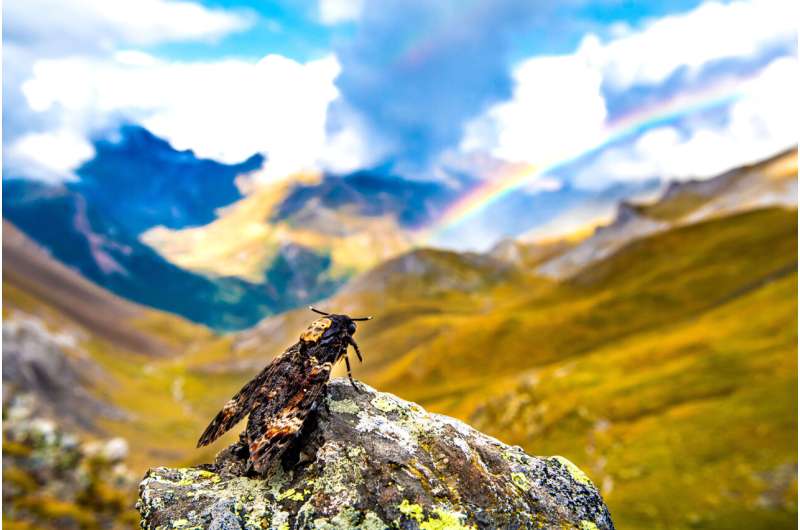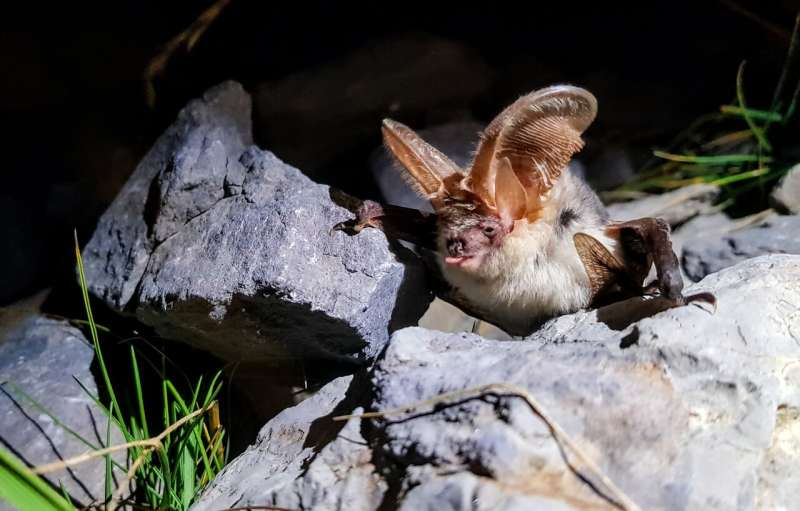This article has been reviewed according to Science X's editorial process and policies. Editors have highlighted the following attributes while ensuring the content's credibility:
fact-checked
peer-reviewed publication
trusted source
proofread
New research shows bats feast as insects migrate through Pyrenees

Bats gather to feast as nocturnal insects fly through mountain passes in the Pyrenees each autumn, new research shows.
University of Exeter scientists identified seven bat species and 66 insect species (90% of which were moths) in the Pass of Bujaruelo, near Spain's border with France. The paper, published in the journal Royal Society Open Science, is entitled, "Bat activity correlated with migratory insect bioflows in the Pyrenees."
The study shows that migrating insects are a vital food source for both migrating bats and those that live in the mountains.
It also provides the first ever evidence of migratory bats feeding on migratory insects while both are migrating.
"Mountain passes are hotspots for a wide variety of insect species that fly south in the autumn," said Dr. Will Hawkes, of the Center for Ecology and Conservation on Exeter's Penryn Campus in Cornwall.
"This migration of nocturnal insects happens over about two months each autumn, but varying weather conditions mean there are just three or four key nights each year when large numbers of insects fly through the Pass of Bujaruelo.
"On these nights, activity of both migratory and residential bat species increased significantly, suggesting these are important moments for the bats to build and maintain their energy reserves."

Dr. Hawkes said migratory bats may use the influx of insects as a "refueling station" to power their own journeys south.
He added, "In highlighting the importance of major insect migrations, our study also shows how fragile ecosystems can be.
"Research in the UK has showed a long-term decline in moth numbers, and moths face a variety of threats including climate change, light pollution, pesticides and habitat loss.
"The insects migrating through the Pyrenees come from hundreds of even thousands of miles away, so the threats they face across that area could all have an impact on the bats.
"For example, European free-tailed bats live in these mountains, and their young are born in the autumn—so it appears they depend on these migrations to feed their offspring and build up energy for hibernation."
The species preyed on by the bats included the cotton bollworm, a moth whose caterpillars are a major crop pest. By eating species such as this, bats may provide an important pest-control service that helps humans.

Explaining the origins of the study, Dr. Hawkes said, "Karl Wotton (co-author) and I were in the pass at night in 2018, a year before the study commenced, and we could hear the feeding buzzes of the bats.
"It was this lucky encounter of us being in the right place at the right time that made us think that maybe the bats are specifically targeting the migratory moths as the bats themselves migrate too."
Joint first author Kelsey Davies added, "The sheer level of activity at the pass of both bats and insects was amazing to see."
More information: Kelsey Davies et al, Bat activity correlated with migratory insect bioflows in the Pyrenees, Royal Society Open Science (2023). DOI: 10.1098/rsos.230151. royalsocietypublishing.org/doi/10.1098/rsos.230151
Journal information: Royal Society Open Science
Provided by University of Exeter




















